Dengue in Vietnamese infants--results of infection-enhancement assays correlate with age-related disease epidemiology, and cellular immune responses correlate with disease severity
- PMID: 18598189
- PMCID: PMC2730540
- DOI: 10.1086/590117
Dengue in Vietnamese infants--results of infection-enhancement assays correlate with age-related disease epidemiology, and cellular immune responses correlate with disease severity
Abstract
The pathogenesis of severe dengue is not well understood. Maternally derived subneutralizing levels of dengue virus-reactive IgG are postulated to be a critical risk factor for severe dengue during infancy. In this study, we found that, in healthy Vietnamese infants, there was a strong temporal association between the Fc-dependent, dengue virus infection-enhancing activity of neat plasma and the age-related epidemiology of severe dengue. We then postulated that disease severity in infants with primary infections would be associated with a robust immune response, possibly as a consequence of higher viral burdens in vivo. Accordingly, in infants hospitalized with acute dengue, the activation phenotype of peripheral-blood NK cells and CD8+ and CD4+ T cells correlated with overall disease severity, but HLA-A*1101-restricted NS3(133-142)-specific CD8+ T cells were not measurable until early convalescence. Plasma levels of cytokines/chemokines were generally higher in infants with dengue shock syndrome. Collectively, these data support a model of dengue pathogenesis in infants whereby antibody-dependent enhancement of infection explains the age-related case epidemiology and could account for antigen-driven immune activation and its association with disease severity. These results also highlight potential risks in the use of live attenuated dengue vaccines in infants in countries where dengue is endemic.
Figures





References
-
- Guzman MG, Kouri G. Dengue: an update. Lancet Infect Dis. 2002;2:33–42. - PubMed
-
- Graham RR, Juffrie M, Tan R, et al. A prospective seroepidemiologic study on dengue in children four to nine years of age in Yogyakarta, Indonesia. I. Studies in 1995-1996. Am J Trop Med Hyg. 1999;61:412–9. - PubMed
-
- Thein S, Aung MM, Shwe TN, et al. Risk factors in dengue shock syndrome. Am J Trop Med Hyg. 1997;56:566–72. - PubMed
-
- Burke DS, Nisalak A, Johnson DE, Scott RM. A prospective study of dengue infections in Bangkok. Am J Trop Med Hyg. 1988;38:172–80. - PubMed
Publication types
MeSH terms
Substances
Grants and funding
LinkOut - more resources
Full Text Sources
Other Literature Sources
Medical
Research Materials

